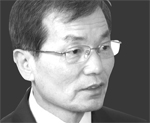Create central control tower

Jeong Sang-man
We were utterly disappointed by the clumsiness, incompetence and shortcomings the Ministry of Security and Public Administration displayed in running the disaster control headquarters after the Sewol ferry sank on April 16 off the nation’s southern coast.
The public became concerned about the government’s capability of handling major crises and disasters due to the chaotic and inefficient way the authorities dealt with the rescue mission.
The government’s preparedness and responsiveness to disasters has been questioned for a long time. The main issue is that it has never seriously thought about fixing the problems.
As always, the hierarchy of command is one element behind the bureaucratic system’s slow actions. Having to go up the chain of command takes too much time when trying to make decisions quickly.
Additionally, the basic disaster and safety control law that is currently in place was passed despite strong protest and concern from academic and civilian groups. It divides the jurisdiction to manage man-made and natural disasters between the Ministry of Security and Public Administration and the National Emergency Management Agency, respectively.
Few other advanced countries separate their state-level hazard response functions because all disasters can cause loss of life and property.
The president arrived to Jindo, the nearest county to the Sewol disaster, on the second day of the sinking and listened to complaints from the families of victims and missing passengers. She then ordered a unified control tower.
As a person who has long studied emergencies and safety management, I strongly advise the creation of a new government agency on safety control. Past lessons suggest the alternative idea of placing a vice-ministerial level office in charge of emergency management within the Ministry of Security and Public Administration won’t do any good.
The country has had a long record of disasters, including the caving in of a department store and bridge in Seoul, and the collapse of a subway construction site in Daegu in the 1990s. The government created a disaster management bureau as a response. But it was scaled down, merged and disappeared when nothing happened for some years.
The government then created the National Emergency Management Agency when typhoons and a fire caused major casualties in the early 2000s. But the agency exists merely in name, with no research arms, training or regulating power.
If disaster control falls under the Ministry of Security and Public Administration, as in the past, we cannot expect responsible and independent action to cope with and prevent emergencies.
The new agency needs to do more than just combine administrative responses to man-made and natural disasters. One of our bureaucratic system’s major drawbacks is that the players and referees are under the same roof.
The Ministry of Land, Infrastructure and Transport is responsible for both promoting construction and supervising safety. The Ministry of Trade, Industry and Energy oversees both power supply and safety regulations. Safety, therefore, is often neglected for the sake of industrial development.
Safety-related procedures scattered across various government offices should come under one national disaster and safety management agency.
To ensure the authority of the new office, it should be ministerial level. Vice-ministerial-level bureaus are often excluded in cabinet meetings and do not have the right to propose legislation. It also would not have the same authority to command the national Coast Guard.
To ensure we never see another third-world calamity on our territory, we must set up a reliable disaster and safety control tower.
JoongAng Ilbo, April 30, Page 26
Translation by the Korea JoongAng Daily staff.
* The author is a professor of construction and environmental engineering at Kongju National University and head of the Korean Society of Hazard Mitigation.
BY Jeong Sang-man










with the Korea JoongAng Daily
To write comments, please log in to one of the accounts.
Standards Board Policy (0/250자)